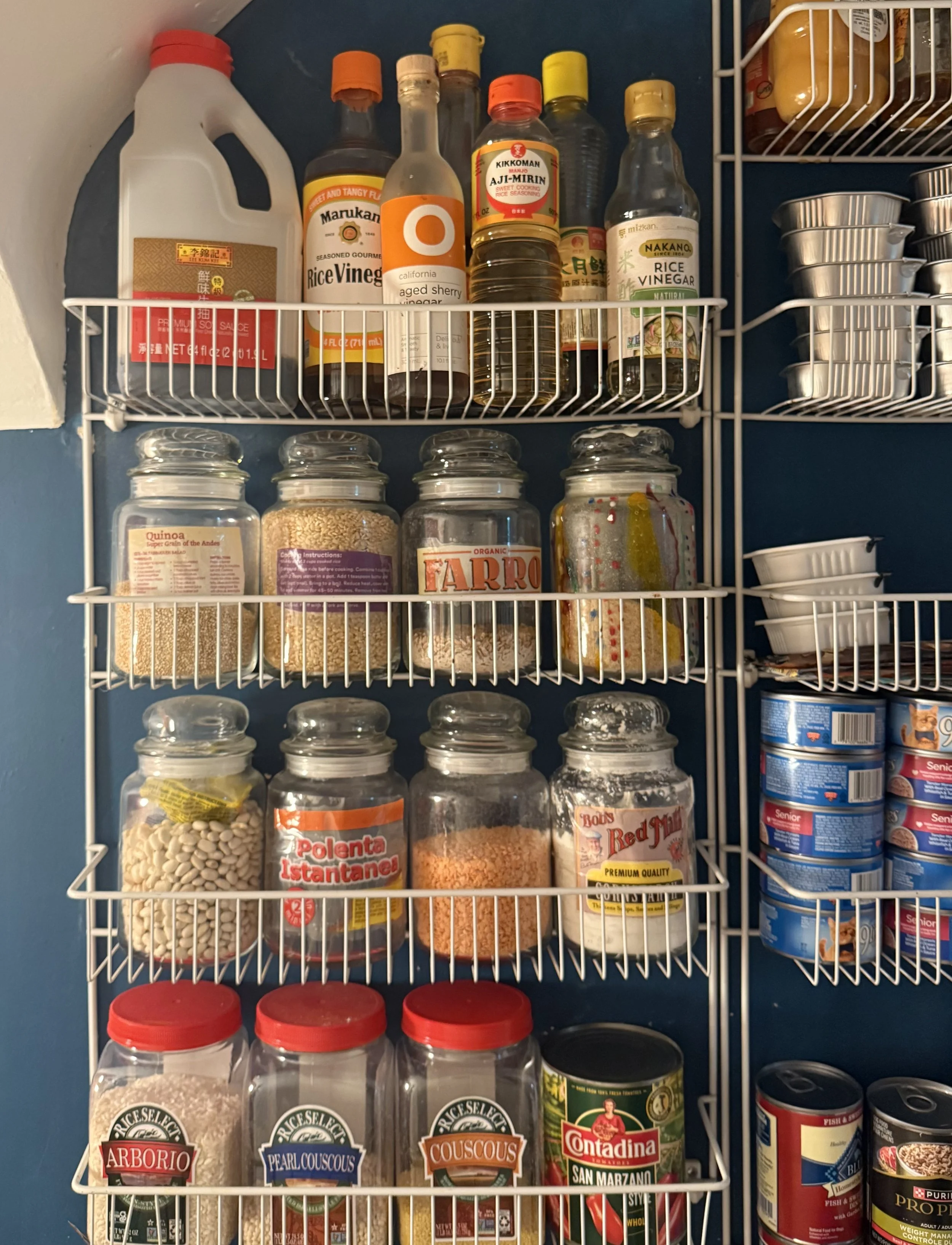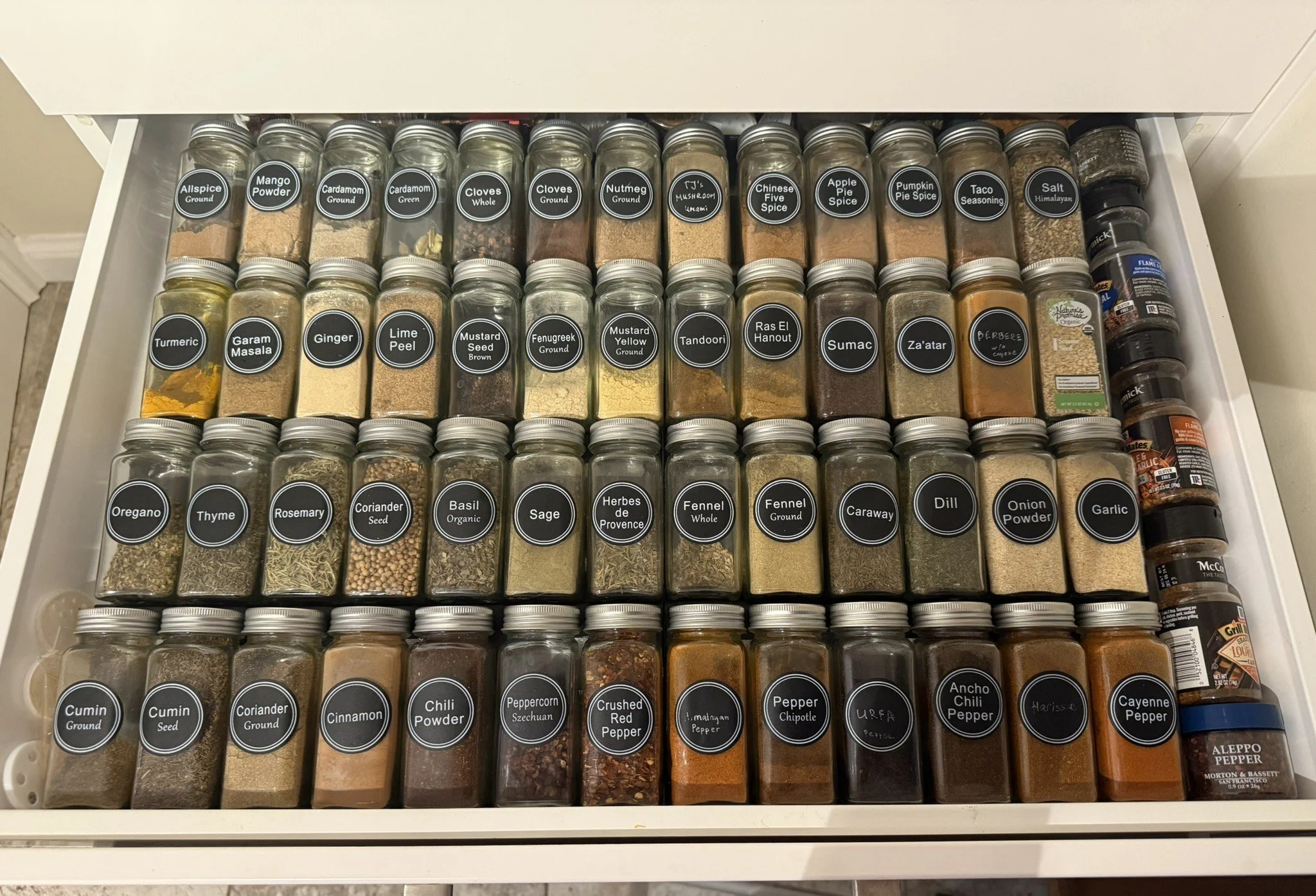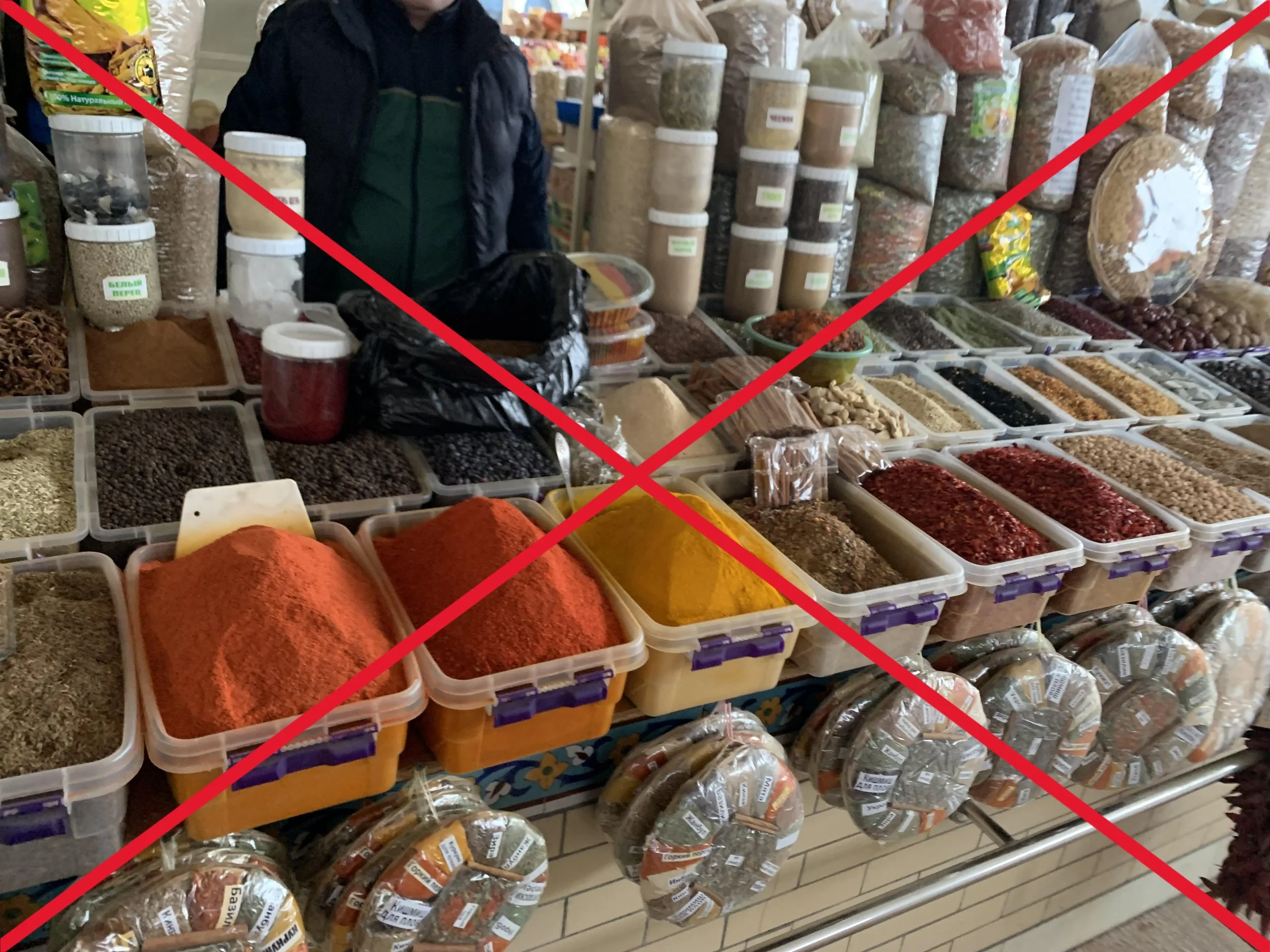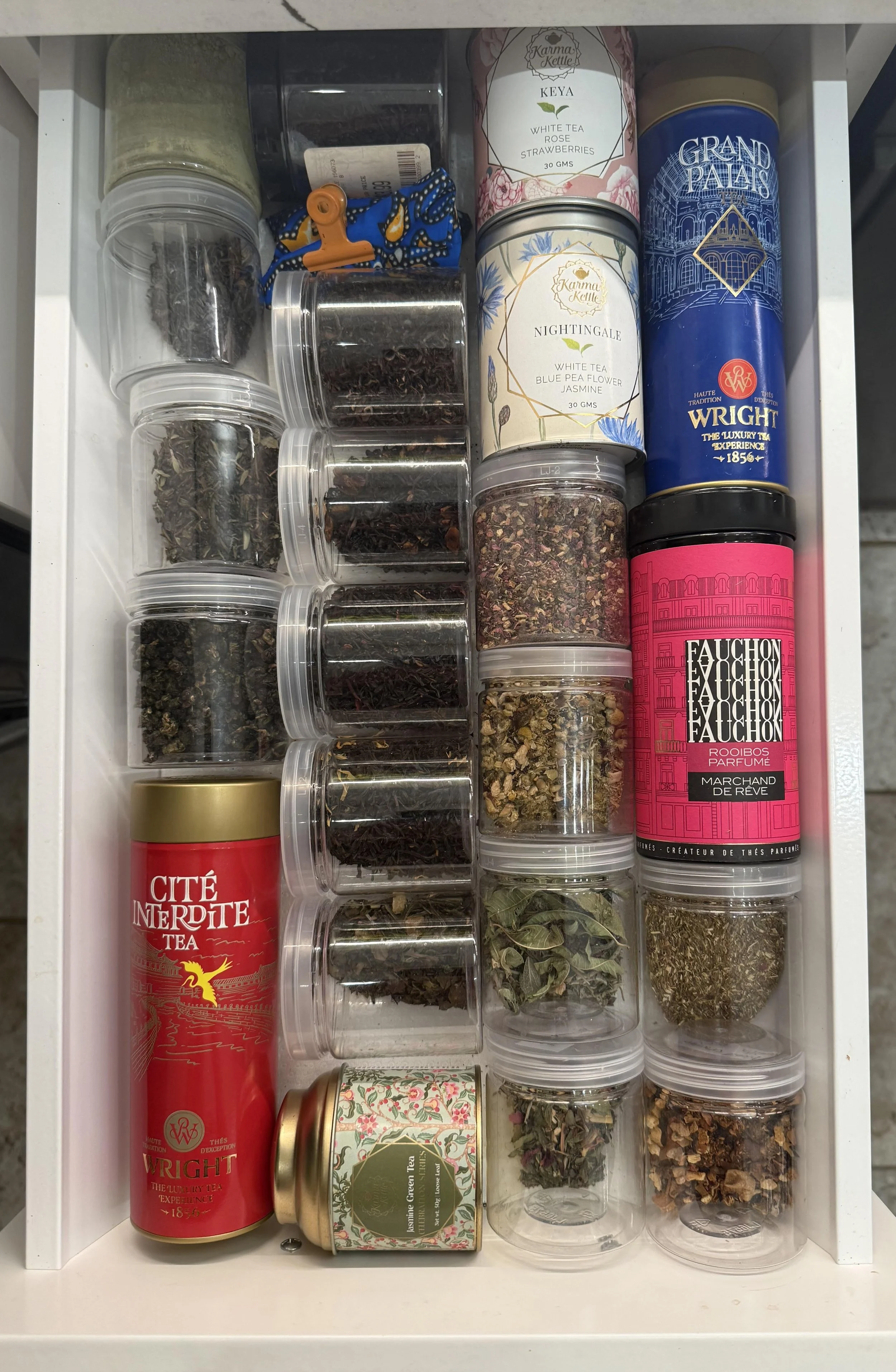Pantry Guide
This resource covers the very basic pantry supplies you will find very useful to have on hand in your routine cooking practice, and in particular on those rainy, snowy, or simply very busy days when you don’t have the time to think about shopping and need to feed yourself or family quickly. I included here categories of products which should make it easier to organize your pantry and keep track of what you have and what you might be running out of and need to re-supply, including the following:
Pasta, grains, and flour
Canned goods
Oils
Spices and seasoning
Condiments and dried fruit
Additionally, I include the produce that has a long-ish shelf life that most cooks would use routinely and the “pantry” of the fridge and freezer, for completeness.
The last section of the guide covers tips for managing your pantry.
Pasta, Grains, Legumes, and Flour
I always keep on hand a good selection of pastas, rice, various grains, lentils, and flours. It’s easy to whip up a quick and healthy supper with just spaghetti, canned tomatoes, and some olives. Here is a good starting list for your pantry:
Spaghetti and pasta with different shapes
Rice: basmati for Mediterranean and Indian dishes; jasmine for Southeast Asian and Latin American dishes; arborio for cooking risotto and paella; brown basmati as a healthy substitute for white rice in some dishes
Lentils (red, green, puy) and dry beans or bean mixes
Flour, cornstarch, baking soda, and baking powder
Tortillas (for taco nights!)
Depending on your preferences, you might also like to have on hand such shelf-stable staples as oats, barley, couscous, bulgur, quinoa, corn grits, and farro.
Pantry drawer with pasta; pantry shelf with varieties of rice
Canned and Jarred Products
Canned products are often superior to their fresh versions (say, tomatoes in the winter), they keep really long time, and they can save a lot of time. For example, if you are fan of chickpeas (like I am!) but don’t want to bother with soaking and then cooking them for a long time, buying canned is the way to go. (Purists would argue about the superior taste of freshly cooked legumes over their canned brethren, and I don’t disagree - it’s likely much better - but after a long day this is the last thing I worry about.)
I always keep on hand the following, to help me out in a pinch to make a quick meal:
Canned chickpeas and various beans
Canned or jarred tomatoes (whole, diced, crushed, and paste); imported Italian preferred
Canned coconut milk (for Asian dishes)
Olives (black and green - they are used differently)
Tahini (for making hummus)
Preserved lemons (for cooking Moroccan tagines)
Oil
Oil is necessary for cooking, and there are so many different varieties out there! How to choose? There has been a lot of debate in the media and on socials about the virtues and vices of different oils. I try not to obsess too much about it and prioritize flavor (or lack thereof), freshness, and cost over fads. Here is what I have on hand:
Olive oil for seasoning food as well as for cooking with
Vegetable oil for cooking (any unflavored oil of your preference)
Sesame oil for flavoring some Asian dishes
Coconut oil for Asian dishes as well as baking
Olive oils in particular range in cost very significantly; I usually keep a bottle of nice stuff for flavoring salads, and cheaper “cooking olive oil” for, well, cooking with.
Spices, Herbs, and Seasoning
Seasoning is essential in cooking; it’s the variation in seasoning rather than ingredients that creates unique tastes of different cuisines and dishes. Buying seasoning can be rather pricey so it’s important to know what flavors you like and build out your seasoning supply around your taste preferences. I organized the list of spices and herbs around cooking preferences, starting with the basic list that everyone who cooks at home should have and supplementing it with the lists of seasoning used in two most popular cuisines in the US - Mediterranean and Asian.
Basic Spices, Dried Herbs, and Seasoning
The list below includes spices, dried herbs, and seasoning that most home cooks will use routinely. Most spices and dried herbs will keep quite well if stored away from heat and light (ideally in a pantry cabinet or a drawer). Some spices, like paprika or white pepper, tend to lose their potency faster than others and it is recommended to keep them in the freezer.
Salt (kosher salt for everyday cooking; sea salt for some dishes)
Sugar (regular cane, brown, and fine or powdered for baking)
Bay leaves (whole)
Black pepper (whole, with a grinder);
Cinnamon (sticks as well as ground)
Chili peppers of any preferred variety (whole)
Crushed red pepper flakes and/or cayenne pepper (ground)
Cumin (ground)
Garlic powder
Nutmeg (whole with a grater or ground)
Onion powder
Oregano
Paprika - smoked or regular or both (store in the freezer)
White pepper (ground; store in the freezer)
Seasoning mix of your choice (e.g, taco seasoning)
Many spices and herbs are much cheaper to buy in bulk, but the economics only work if you use them frequently enough to get through large quantities before they lose their potency.
My spice drawer (you can purchase spice jars with labels and a drawer rack from amazon.com (here is the link to this set).
Where to Buy Spices?
It is very important to buy spices from a reputable source. There have been studies (see here and here) that found high lead concentration in many spices in use in the US, many of which were purchased in US stores. Lead exposure can cause developmental and cognitive issues in children, and contribute to increased blood pressure, hearing loss, and gastrointestinal distress in adults. Recent analysis of Beethoven’s hair revealed that the deafness and eventual death of the famous composer was cased, in part, by lead poisoning! It’s better to be safe than sorry and pay an extra dollar for lead-free spices.
Since there are no reliable ways to test for lead at home, I minimize the risk by choosing my spice producers and vendors. Whenever possible, I buy established brands of spices that are labeled “organic” from supermarkets in the area or from reputable sellers online. I am no longer tempted to buy spices from the beautiful market stands in far-away countries!
Additional Spices for Mediterranean Dishes
Mediterranean cuisine has been acclaimed for its health benefits, versatility, and ease of preparation (in many cases). It encompasses traditional foods of countries bordering the Mediterranean Sea - Spain, Italy, Greece, Morocco, and Turkey, among others. (Interestingly, classic French cuisine is not included in the traditional “Mediterranean” diet since it has a very different flavor profile and uses ingredients such as butter and cream which are much less common further south.) I love the collective “Mediterranean cuisine” for its diversity. You can cook Mediterranean every day for a month and have different flavors every day! What can be better? Below is the list of common spices and herbs you want to have on hand (in addition to the list of basic spices above) if you also like to cook Mediterranean.
Allspice (ground)
Baharat spice mix (buy or DIY)
Berbere spice mix (buy or DIY)
Caraway seeds
Cloves (ground)
Cumin seeds (whole)
Ginger (ground)
Paprika - smoked and/or regular (store in the freezer)
Ras el hanout spice mix (buy or DIY)
Saffron (strands)
Sumac (ground)
Turmeric (ground)
Urfa flakes
Za’atar
Some of these spices and herbs are not readily available in an average supermarket and you might have better luck finding them online. Others, like the famous ras el hanout and baharat spice mixes, can be prepared at home with spices from this list. You can find recipes for them online. I like preparing my own mixes since I have more control over the final product (remember the whole lead issue!) as well as how hot the mix is (some recipes ask for way too much cayenne, in my opinion).
Ingredients for the Ras el Hanout spice mix (photo from Silk Road Recipes website; recipe link)
Additional Spices for Asian Dishes
Asian takeout places and restaurants are very popular in the US, and for a good reason - Chinese, Japanese, Indian, Thai, Vietnamese, Pakistani, and many other Asian cuisines delight the eye, the nose, and the tastebuds in their bright flavors as well as colors. They are also frequently less expensive than traditional American or European options.
In over twenty years of cooking Asian dishes at home, I learned that it is a) much easier than it looks - as long as you have necessary ingredients, and b) can be very inexpensive and healthy. Many Asian dishes are vegan or vegetarian, and when they do use meat, a little goes a long way. Here is the list of spices you would need in addition to the basic ones covered above:
Cardamom (whole and ground)
Chinese five spice mix
Coriander (ground)
Curry powder spice mix
Fennel seeds (whole)
Garam masala spice mix
Kashmiri chili powder
Mustard seed (whole, ground)
Sichuan peppercorns (red, whole)
Turmeric (ground)
In addition to these spices, certain condiments are necessary for cooking Chinese dishes: Shaoxing wine and/or mirin or dry sherry, Chinese black vinegar, and a variety of condiments such as chili bean paste and fermented black beans. Fish sauce and dried shrimp are commonly used in Thai cuisine.
Fridge and Freezer “Pantry”
I always keep certain condiments, cheeses, and basic ingredients like eggs in the fridge or freezer since I tend to use them frequently and it’s worth dedicating some fridge space to them:
Butter or substitute
Capers
Chicken stock (if you don’t have the time to make homemade, “Better than bouillon” brand is great and keeps in the fridge forever)
Dijon mustard
Eggs
Ginger
Hoisin and oyster sauces (for Asian dishes)
Lemons
Nuts that you like (walnuts, almonds, pekans, pine nuts, etc - best kept in the freezer)
Parmesan and/or feta cheese
Worcestershire sauce (for European dishes)
Condiments and Dried Fruit
Below is a list of basic condiments and additives that can help enhance the flavor and texture of your dishes:
Soy sauce
Vinegars (plain white, red wine, apple cider, rice, sherry)
Anchovy paste (or whole anchovy)
Dried fruit that you like (yellow or red raisins, currants, apricots, cherries)
Honey (optional - in most recipes sugar can be used instead of honey)
Basic Shelf-Stable Produce
I think 99% of dishes (ok, maybe I am exaggerating just a little bit!) include alliums (onion, garlic, shallots, scallions) as the base for the dish’s aromatic profile. Since onions and garlic store remarkably well, you wouldn’t catch me without them even in a snowstorm that happens in DC every few years. Potatoes are also great to keep on hand - they store reasonably well if you keep them in a cool, dry, and dark place. Potatoes are ubiquitous in world cuisines and are deeply satisfying in whatever form you choose to serve them.
Tips for Efficient Pantry Management
A lot of home cooks struggle with organizing and managing their pantry. It’s hardly surprising given how many items even the least ambitious cook needs to keep in their pantry. Below is a list of tried and proven strategies to ensure your pantry is the source of ingredients, not frustration.
Organize your pantry by use frequency, making sure the items you use frequently are the most accessible. Look at your kitchen setup with a critical eye and assess your use of space. Maybe you are storing a rarely used pot on an easily accessible shelf and frequently used bag of flour in the back of a drawer. Consider swapping them! It is your kitchen, so organize it however it works best for you.
Invest in storage containers. They are not that expensive, and they are worth it. I found this particularly applies to spices, rice, flour, and sugar - basically, things that are used frequently, spill easily, and can benefit from being stored in air-tight containers.
Ensure your pantry is appropriately accessible. While it might be tempting to shove a lot of things onto a high shelf, it also means those items will be easily forgotten. Don’t buy more items than you can store accessibly. If you must, then figure out an overflow system. For example, I buy 25 lb bags of basmati, jasmine, and sushi rice in Costco; I keep what I need super accessible in my kitchen in clear plastic containers, labeled, and store the rest in the basement. Obviously, an overflow system will only work if you have space for that. Another issue is that a lot of kitchens come with deep cabinets which are not at all conducive to storing things in an accessible way. There are solutions to this problem, from converting them into drawers (it’s cheaper and easier than you think - just search YouTube) to investing in shelf risers.
Implement a periodic review of what you have, to weed out any spoilage and also to remind yourself what you have on hand. You will be surprised to find duplicates!
23 types of loose tea organized accessibly in a kitchen drawer
All photos are by FoodFirst unless specified








